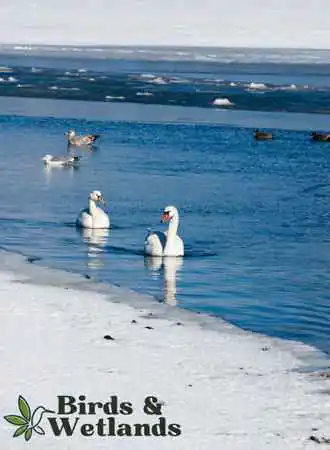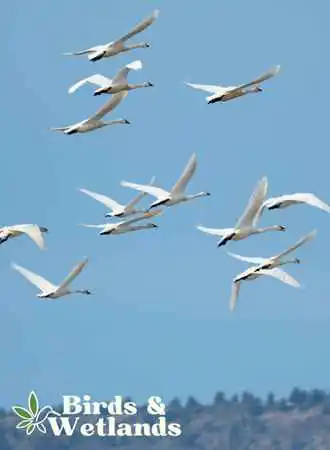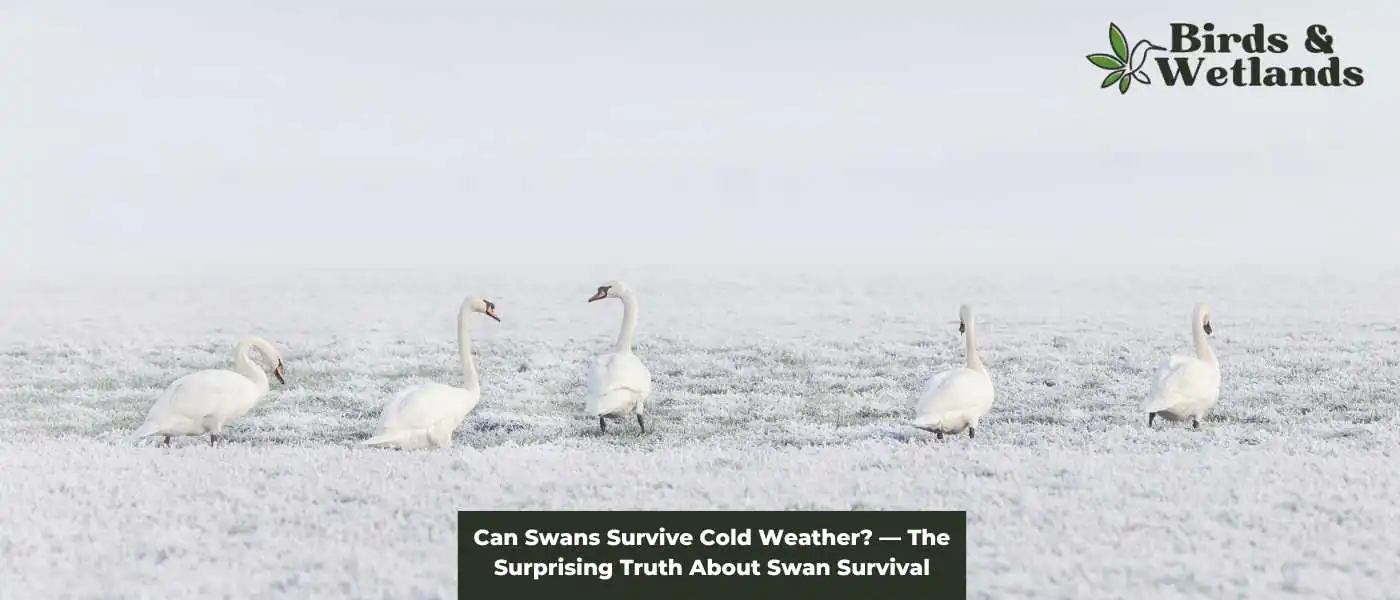Swans are a group of large water birds known for their grace and beauty. Some species of swans, such as the tundra and trumpeter swans, have unique adaptations that allow them to survive in cold weather.
These adaptations include a thick layer of downy feathers that insulate them from the cold and webbed feet that help them swim in icy waters.
Despite their ability to survive in cold weather, many swan species still migrate in the winter in search of food and more temperate climates.
Even though they have adapted to the cold, the harsh winter conditions can still make it difficult to find enough food to survive. Therefore, they move to areas where they can find more food, such as wetlands or coastal regions.
Key Takeaways on Do Swans Survive the Bitter Cold
- Swans are well adapted to the cold, but some species are more suited to it than others.
- Swans can survive in frozen water, but it’s not ideal for them.
- Swans have adaptations such as thick downy feathers and webbed feet that help them survive in the cold.
Do swans feel the cold?
Yes, swans do feel the cold. Though they are large, feathered birds with many layers of insulating down feathers, swans can suffer from cold temperatures and winter weather just as smaller bird species can.
In fact, a major reason so many of these magnificent birds migrate south during the winter months is to find warmer climates to survive the harsh winter chill.
Some swans are better adapted to cold weather than others. For example, the trumpeter swan, which lives in northern parts of North America, has a thick layer of downy feathers that help keep it warm in freezing temperatures. Waterfowl head, wings, legs and feet are also important in regulating body heat or body temperature to stay warm.
On the other hand, the mute swan, a swan species native to northern Europe and Asia, has less dense plumage and may not be as well adapted to the cold. Moreover, mute swans are non-migratory birds and stay year-round in their range.

Can swans survive in frozen water?
Yes, swans can survive in frozen water. In fact, many species of swans can tolerate cold water and icy conditions. For example, eastern tundra swans which breed in Arctic tundra and migrate to southern regions in winter, are known to thrive in the coldest conditions.
However, it’s important to note that while more swans can survive in frozen water, it’s not ideal for them. If the water is frozen over for long periods of time, it can be difficult for them to find food, which can lead to malnourishment and other health issues.
Additionally, in case of extreme cold, they might not be able to fly, which can make them vulnerable to predators such as bald eagles, coyotes, foxes and other wild animals.

Where do swans live in the winter?
In North America, swans typically migrate to warmer areas in the winter to avoid the cold temperatures and lack of food. The two main types of swans native to North America are the trumpeter swan and the tundra swan (subspecies include the whistling swan and Bewick swans).
Trumpeter swans usually migrate to the southern parts of the United States, such as the states of Oregon, California, Nevada and New Mexico. Some also migrate to Mexico and Vancouver Island.
On the other hand, tundra swans typically migrate to the Atlantic Coast, where they can be found in states like Maryland, Virginia, and North Carolina. Some also migrate as far south as Florida.
It’s important to note that not all swans migrate. Some swans will stay in the same area year-round if the conditions suit them. For example, swans that live in milder climates or near bodies of water that do not freeze over in the winter may not need to migrate.

Do mute swans migrate in the winter?
Mute swans in North America typically do not migrate in places where they live. Some birds may travel short distances to find better food sources in the winter months, but most of them stay within their near their breeding grounds.
Mute swans can survive in cold climates because they have thick layers of feathers and a layer of down that keeps them warm. They also can find open water during the winter months, which allows them to continue foraging for food.
For example, in New York, mute swans are found throughout the state and are not observed to migrate during the winter. They can be found in parks, ponds, lakes, and rivers all year.
It’s worth noting that mute swans are considered an invasive species in many parts of North America. They can have negative impacts on other swans and aquatic ecosystems. Due to this, many states have implemented management plans to reduce their populations.
How do swans know when to migrate in the winter?
Swans are birds that migrate in the winter or late fall to warmer climate. Like other birds, they know when to migrate because they have a built-in biological clock called a circadian rhythm. This clock tells them when the days are getting shorter, and when temperatures drop, signaling that it is time to leave for warmer places.
Another factor that plays a role in a swan’s migration is food availability. Most swans will migrate to places where there is more food for them to eat. For example, when the lake and pond in their current location freeze, many migrating swans need to find open water and food sources elsewhere.
Swans also have a strong homing instinct, which means they have a natural ability to find their way back to their breeding grounds. They use a combination of cues such as the position of the sun, the earth’s magnetic field and landmarks to navigate during migration.
In addition, swans often migrate long distances during cold months in flocks led by an experienced adult bird. Young cygnets look to these leaders to learn the migration routes and follow them to their destination.

Do whooper swans live in North America?
No, the whooper swan breeds in eastern Siberia. However, some flocks of whooper swans fly to the Aleutian Islands and parts of western Alaska in the winter. These birds are considered vagrants.
Do black-necked swans migrate to North America?
No, black-necked swans don’t migrate to North America in the winter.


